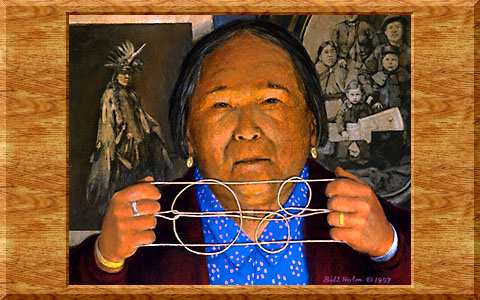
Original acrylic, cotton seine twine, epoxy filler, on hardboard 10" x 12"
by Bill Holm © 1997
Collection of Edward Marcuse
"Sun, Moon, and Star" (Tl!isalabalis, Makwalabalis, T!ot!obalis) is one of a vast array of figures known to Kwakwaka'wakw people that are made by manipulating a loop of string with the fingers. Techniques of producing "string-figures" are known to peoples around the world, and some North American cultures, Eskimo and Navajo for example, have prodigious repertoires. Kwakwaka'wakw examples range from simple, one-movement examples like the "Jumping Sand-flea" to complex narrative illustrations, often accompanied by dialogue or song, where a younger brother jumps past his older brother, an old woman crosses a river, a canoe capsizes throwing its crew into the water, salmon jump from stream after stream in Knight Inlet, and on and on. Some are illustrations of myths and some are competitive, designed to best other string-figure makers.
The late Kwakwaka'wakw chief, Mungo Martin, and his wife Abayah, were experts, and my wife, Marty, and I spent many an evening, long into the night, trying to emulate their graceful, rhythmic movements in bringing the string loop to life. One of the first complex figures we learned was "Sun, Moon, and Star." Abayah was particularly adept, and I mean to show her here, forming the interlocking loops of that figure. Behind her appear two old photographs. One, by Edward Curtis, is of the young Tl!akwagilayugwa (Abayah's noble name) in the dress of the Weather Dancer. The other is of her family, with her at about two years of age, holding her father's great copper.